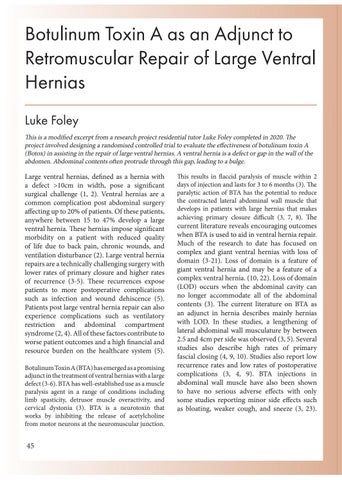Botulinum Toxin A as an Adjunct to Retromuscular Repair of Large Ventral Hernias Luke Foley This is a modified excerpt from a research project residential tutor Luke Foley completed in 2020. The project involved designing a randomised controlled trial to evaluate the effectiveness of botulinum toxin A (Botox) in assisting in the repair of large ventral hernias. A ventral hernia is a defect or gap in the wall of the abdomen. Abdominal contents often protrude through this gap, leading to a bulge.
Large ventral hernias, defined as a hernia with a defect >10cm in width, pose a significant surgical challenge (1, 2). Ventral hernias are a common complication post abdominal surgery affecting up to 20% of patients. Of these patients, anywhere between 15 to 47% develop a large ventral hernia. These hernias impose significant morbidity on a patient with reduced quality of life due to back pain, chronic wounds, and ventilation disturbance (2). Large ventral hernia repairs are a technically challenging surgery with lower rates of primary closure and higher rates of recurrence (3-5). These recurrences expose patients to more postoperative complications such as infection and wound dehiscence (5). Patients post large ventral hernia repair can also experience complications such as ventilatory restriction and abdominal compartment syndrome (2, 4). All of these factors contribute to worse patient outcomes and a high financial and resource burden on the healthcare system (5). Botulinum Toxin A (BTA) has emerged as a promising adjunct in the treatment of ventral hernias with a large defect (3-6). BTA has well-established use as a muscle paralysis agent in a range of conditions including limb spasticity, detrusor muscle overactivity, and cervical dystonia (3). BTA is a neurotoxin that works by inhibiting the release of acetylcholine from motor neurons at the neuromuscular junction.
45
This results in flaccid paralysis of muscle within 2 days of injection and lasts for 3 to 6 months (3). The paralytic action of BTA has the potential to reduce the contracted lateral abdominal wall muscle that develops in patients with large hernias that makes achieving primary closure difficult (3, 7, 8). The
current literature reveals encouraging outcomes when BTA is used to aid in ventral hernia repair. Much of the research to date has focused on complex and giant ventral hernias with loss of domain (3-21). Loss of domain is a feature of giant ventral hernia and may be a feature of a complex ventral hernia. (10, 22). Loss of domain (LOD) occurs when the abdominal cavity can no longer accommodate all of the abdominal contents (3). The current literature on BTA as an adjunct in hernia describes mainly hernias with LOD. In these studies, a lengthening of lateral abdominal wall musculature by between 2.5 and 4cm per side was observed (3, 5). Several studies also describe high rates of primary fascial closing (4, 9, 10). Studies also report low recurrence rates and low rates of postoperative complications (3, 4, 9). BTA injections in abdominal wall muscle have also been shown to have no serious adverse effects with only some studies reporting minor side effects such as bloating, weaker cough, and sneeze (3, 23).









